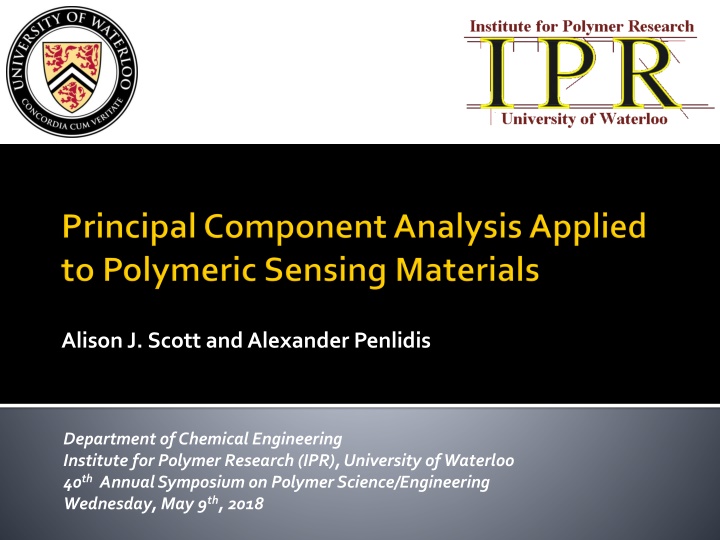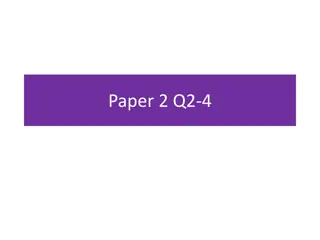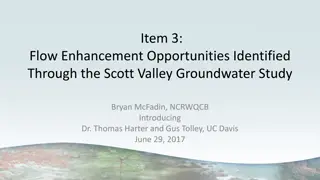
Gas Analyte Detection using Polymeric Sensing Materials: Advantages and Applications
Explore the benefits of gas analyte detection using polymeric sensing materials, including increased sensitivity, selectivity, and customization potential. Learn about the importance of factors like sensitivity and selectivity in sensor technology, as well as the role of Principal Component Analysis (PCA) in data analysis for sensor arrays.
Uploaded on | 2 Views
Download Presentation

Please find below an Image/Link to download the presentation.
The content on the website is provided AS IS for your information and personal use only. It may not be sold, licensed, or shared on other websites without obtaining consent from the author. If you encounter any issues during the download, it is possible that the publisher has removed the file from their server.
You are allowed to download the files provided on this website for personal or commercial use, subject to the condition that they are used lawfully. All files are the property of their respective owners.
The content on the website is provided AS IS for your information and personal use only. It may not be sold, licensed, or shared on other websites without obtaining consent from the author.
E N D
Presentation Transcript
Alison J. Scott and Alexander Penlidis Department of Chemical Engineering Institute for Polymer Research (IPR), University of Waterloo 40thAnnual Symposium on Polymer Science/Engineering Wednesday, May 9th, 2018
Why Gas Analyte Detection? Analyte Ethanol Application Reduce drinking & driving Acetone Diagnose diabetes Benzene Monitor indoor air quality Why Polymeric Sensing Materials? Good sensitivity and selectivity Room temperature operation Product customization potential Backbone/functional group selection & polymer doping 2
Sensitivity: Related to sensor s detection limit Lower detection limit = more sensitive sensor Selectivity: Ratio between responses (target analyte vs. interferent analyte) 3 Stewart, KME; Chen, WT; Mansour, RR; Penlidis, A. (2015) Journal of Applied Polymer Science132 (28).
Analyte FM MFC PC Passive Mixer Gas Chromatograph Analyte MFC Analyte MFC Sample MFC: Mass Flow Controller, PC: Pressure Controller, FM: Flow Meter, GC: Gas Chromatograph 4 Stewart, KME; Penlidis, A. (2013) Macromolecular Symposia 324 (1).
Experimental work large data sets PCA allows us to see useful trends (and clusters) PCA helps us to determine inter- relationships among variables Algorithm Filtering For sensing materials, PCA acts in essence as a filtering algorithm Collect responses from a variety of sensing materials Combine data to simulate a sensor array 5
How does PCA work? Decomposes the data matrix (n observations & p variables) into: a) A score matrix (related to observations/cases) b) A loading matrix (related to variables) x n Data n Scores Loadings m p p m These show us the inter-relationships among the observations and among the variables 6
Use PCA as a filtering algorithm for sensing materials Loadings: show separation between analytes (variables) to distinguish between different cases Scores: provide information about how observations are linked 7
Derivative of polyaniline, poly-o-anisidine (PoANI) Undoped Doped with NiO or ZnO nanoparticles Use individual materials (or combinations) to detect gas analytes Methanol, ethanol, acetone & benzene 8
Loadings: which combination of factors Projection of the variables on the factor-plane ( 1 x 2) gives best separation? Projection of the variables on the factor-plane ( 1 x 3) 1.0 1.0 Ethanol 0.5 0.5 Ethanol Acetone Methanol Factor 2 : 33.24% Factor 3 : 32.25% Benzene 0.0 0.0 Methanol -0.5 -0.5 Acetone Benzene -1.0 -1.0 -1.0 -0.5 0.0 0.5 1.0 -1.0 -0.5 0.0 0.5 1.0 Factor 1 : 33.29% Active Factor 1 : 33.29% Active 9
Scores: easy distinction between all 4 gases Projection of the variables on the factor-plane ( 1 x 2) (reference plot for unknown gases) 1.0 Ethanol 0.5 Factor 2 : 33.24% Benzene 0.0 Methanol -0.5 Acetone -1.0 Benzene may be difficult to detect in gas mixtures -1.0 -0.5 0.0 0.5 1.0 Factor 1 : 33.29% Active 10
Material Array: combination of 3 PoANI- based sensing materials to improve separation Projection of the variables on the factor-plane ( 1 x 3) 1.0 ZnO_M NiO_M 0.5 PoANI_M Factor 3 : 24.62% 0.0 ZnO_A ZnO_E NiO_E PoANI_A NiO_A PoANI_E PoANI_B ZnO_B -0.5 NiO_B -1.0 -1.0 -0.5 0.0 0.5 1.0 Factor 1 : 32.82% Active 11
4-Gas Mixture: can individual gases still be identified when we include gas mixture data? Experimental data include material responses to: Individual gases: Methanol (M), Ethanol (E), Acetone (A) & Benzene (B) 2-Gas Mixtures: ME, MA, MB, EA, EB, AB 3-Gas Mixtures: MEA, MEB, MAB, EAB 4-Gas Mixture: MEAB 12
3-Material Array: does a material array help Projection of the variables on the factor-plane ( 1 x 2) with gas identification? Projection of the variables on the factor-plane ( 1 x 3) NiO_B 1.0 1.0 ZnO_M NiO_M ZnO_B PoANI_B 0.5 0.5 PoANI_M PoANI_M Factor 2 : 25.19% Factor 3 : 20.07% 0.0 0.0 PoANI_E NiO_B NiO_A PoANI_B PoANI_A ZnO_E NiO_E ZnO_B ZnO_M NiO_M ZnO_A ZnO_A NiO_E PoANI_E NiO_A PoANI_A -0.5 -0.5 ZnO_E -1.0 -1.0 OUTLYING PoANI_M REMOVE PoANI -1.0 -0.5 0.0 0.5 1.0 -1.0 -0.5 0.0 0.5 1.0 Factor 1 : 30.34% Active Factor 1 : 30.34% Active 13
2-Material Array: 2 sensing materials give better separation than 3 (better without PoANI) Projection of the variables on the factor-plane ( 1 x 2) Projection of the variables on the factor-plane ( 2 x 3) 1.0 1.0 NiO_M NiO_B ZnO_M ZnO_B 0.5 0.5 ZnO_M Factor 2 : 27.38% Factor 3 : 24.90% ZnO_A NiO_M NiO_A 0.0 0.0 ZnO_E NiO_E NiO_E ZnO_B NiO_B -0.5 -0.5 NiO_A ZnO_E ZnO_A -1.0 -1.0 -1.0 -0.5 0.0 0.5 1.0 -1.0 -0.5 0.0 0.5 1.0 Factor 2 : 27.38% Active 14 Factor 1 : 34.85% Active
2-Material Array: methanol, ethanol and acetone can be identified individually Benzene & Benzene-containing Mixtures 15
3-Material Array: adding another (benzene- sensitive) material improves array performance 16
Individual Gases: benzene had lowest sorption (hard to detect hard to isolate) Material array provides more sensing info and better separation (vs. individual sensing material response) No interaction between gases (parallel loadings) 17
4-Gas Mixture: benzene interactions prevalent when gas mixtures are analyzed Benzene sorption > acetone sorption for PoANI w ZnO Interactions? Benzene cannot be separated from other benzene-containing gas mixtures 18
Principal component analysis (PCA) is a valuable tool for analyzing sensing data Filtering algorithm provides separation Statistical results agree with physico-chemical expectations Information from PCA allows for tailor-made, improved sensor arrays 19
Alison J. Scott and Alexander Penlidis Department of Chemical Engineering Institute for Polymer Research (IPR), University of Waterloo 40th Annual Symposium on Polymer Science/Engineering Wednesday, May 9th, 2018
Stewart, KME; Penlidis, A. (2013) Macromolecular Symposia 324 (1). Stewart, KME; Chen, WT; Mansour, RR; Penlidis, A. (2015) Journal of Applied Polymer Science132 (28). Stewart, KME; Penlidis, A. (2017) Polymers for Advanced Technologies 28 (3). 21
Sensing Materials vs. Sensors Sensing Material Material Response Sensor Type Conductive Non-Conductive Lightweight Conductivity Capacitance Mass Resistive Sensor Capacitive Sensor Mass-Based Sensor 22
Bulk Polymer Properties Application-Specific Properties Depend on sensor type Glass transition temperature Physical structure Affinity towards target analyte(s) Sensitivity Selectivity Other (e.g. stability) 23
What is PCA? Multivariate data analysis technique Attempts to reduce total number of variables by creating components or factors These factors account for the majority of the variation using fewer data points Method gives us a 2-dimensional window through which we can look at a data set that contains many more variables Algorithm Filtering 24
How does PCA work? Creates factors, which are weighted linear combinations of the original variables Eigenvalues of correlation matrix Active variables only 4.5 ~86% variation in 3 PCs 32.82% 4.0 28.86% 3.5 24.62% 3.0 2.5 z1 = a11 x1 + a12 x2+ + a1p xp Eigenvalue 2.0 First few factors contain most of the variation (for the entire data set), so only a few principal components need to be retained for analysis 1.5 1.0 6.93% 4.92% 0.5 .36%.33%.03% .64%.34% .13% .02% 0.0 -0.5 -2 0 2 4 6 8 10 12 14 Eigenvalue number 25
4-Gas Mixture: separation of gases when mixture data is included in analysis Projection of the variables on the factor-plane ( 1 x 2) Projection of the variables on the factor-plane ( 1 x 3) Projection of the variables on the factor-plane ( 2 x 3) 1.0 1.0 1.0 Methanol Acetone Acetone 0.5 0.5 0.5 Factor 2 : 30.73% Ethanol Factor 3 : 25.92% Factor 3 : 25.92% Ethanol Acetone 0.0 0.0 0.0 Methanol Methanol Benzene -0.5 -0.5 -0.5 Ethanol Benzene Benzene -1.0 -1.0 -1.0 -1.0 -0.5 0.0 0.5 1.0 -1.0 -0.5 0.0 0.5 1.0 -1.0 -0.5 0.0 0.5 1.0 Factor 1 : 37.99% Active Factor 1 : 37.99% Active Factor 2 : 30.73% Active 26
4-Gas Mixture: is one sensing material enough to distinguish between gases? Acetone Methanol Ethanol Benzene Benzene & Benzene-containing Mixtures 27
3-Material Array: adding another (benzene- sensitive) material improves array performance Poly (2,5-dimethyl aniline) doped with NiO 16
PCA: successful filtering algorithm for sensing material data Loadings show separation between analytes & predict degree of separation Outliers suggest which sensing materials may not be appropriate for detecting target analytes Scores show how observations are linked Array performance is based on separation (and identification) of analytes Plots demonstrate how mixtures relate to pure (individual) gases & suggest interactions between gases 15





















